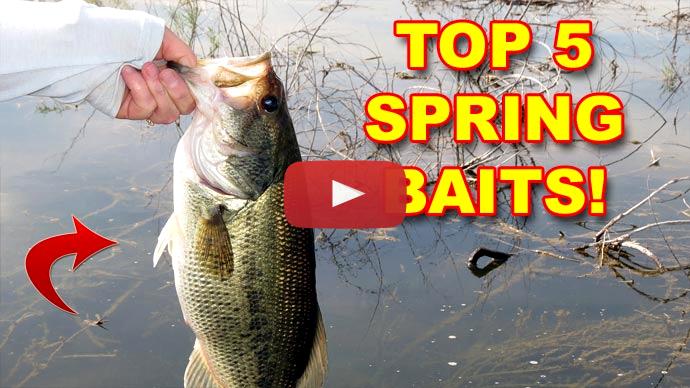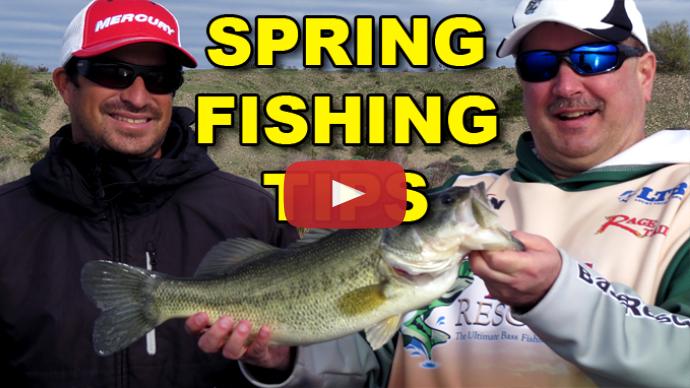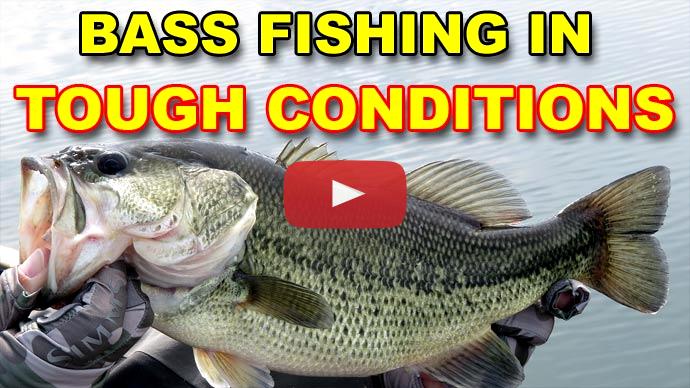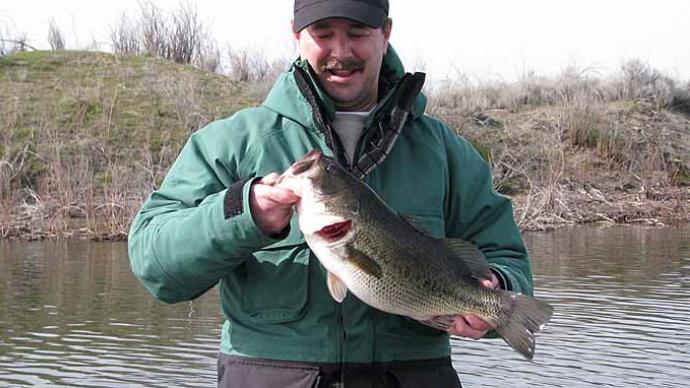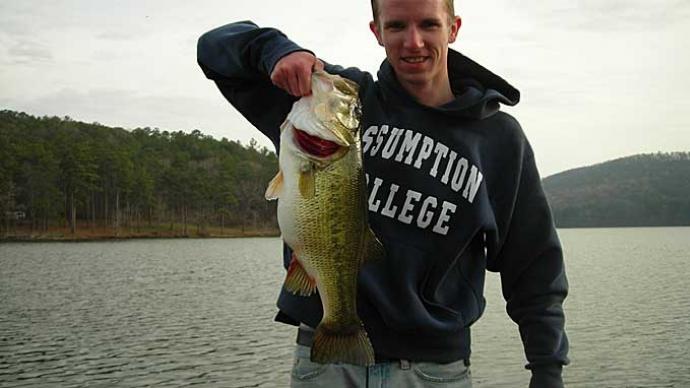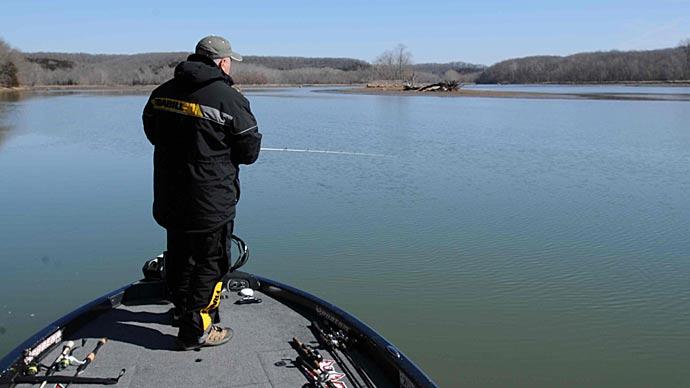Glenn: Holy crap, I can't believe that.
Keri: Fish! Fish! Look at that little guy, little buckaroo. Fish!
Glenn: Yeah. Even after a cold front.
Keri: He was hungry. He said he was hungry, little buck.
Glenn: Yeah, I'll take it.
Keri: Yeah.
Glenn: Hey, folks. Glenn May here with BassResource.com. And today, I wanna talk about early spring fishing and how to catch them. Early spring is a great time to be out fishing because now the fish are moving up from the winter, where the deep spots where they've been all winter long. Now they're starting to move out and getting ready to feed, getting...in preparation for the spawn. So, that's a great time to get out there and start whacking them. But it can be difficult to find them sometimes because, you know, you've got fronts that are coming through. The fish are still deep in a lot of places. It takes a while to figure out where they're moving up shallow. So, today I wanna go through, kind of, a methodology in how to find them, and then what baits to use, and the approach to catch these early-spring bass.
So, let's start off with finding the warm water. You wanna find the warmest water in the lake. Now, it's funny. Back in the '70s and the '80s, when I was watching Orlando Wilson, and Bill Dance, Roland Martin, and watching Bassmasters and In-Fishermen, reading all these magazines, seems like they always said, "Go to the northwest corner of the lake because it warms up first."
I don't know about you, but that's never worked out for me. I don't know what lakes they're fishing, where that occurred, and maybe it works for them, and maybe it happens to work for you in your neck of the woods, but from my experience, northwest corner of the lake doesn't seem to warm up faster than everywhere else. So, I've had to learn a different way to find the warmest water in the lake. So, let me walk you through this. This is a pro tip stuff because this is the stuff I've learned on my own over the decades.
So, first off, what you wanna do is look at a lake map and find the little shallow coves, the shallow bays, not way deep, big, huge flats and the backs of flats. That's not what we're looking for right now. The bass aren't gonna be moving up that shallow, but areas that are relatively shallow compared to the rest of the lake. There's less volume of water in these areas, and if they're protected like a little bay or cove from the wind, they all warm up faster just because there's less volume to warm up. Especially if you get some sunny days, it'll start to warm up a little bit. So, those are the main areas I start to target. But there's more to it than that.
Another way that I find these warmer areas is I pay attention to the weather. And it may not be from what you're thinking. I'm not going where you're thinking. I mean, sure enough, if you get several days of warm weather, sunny days, it's gonna warm the lake up overall, and those shallow areas I just mentioned will warm up a little bit quicker. There's truth to that. However, what I'm looking for is very specific things. I want daytime and night time temps to be five or more degrees warmer for longer than three days, stretch longer than three days, but I want it to be five or more degrees warmer than what it's been for the past several weeks.
So, I wanna see that warming stretch, and I wanna see it combined with rain, the more rain, the better. Nothing warms up a lake faster than warm rain. But there's more to it than that because that's just, like, the sun, again, warming up the entire lake.
What I'd like to focus on during those times, if I get that stretch of three or more days with warmer weather and with rain, is I like to target tributaries, creeks, anywhere where water's coming into the lake. The areas around that will be warmer due to that warmer water coming in. And you can have little hot spots all over the lake, even though it may not be a flat or a cove, but just that area will be a little bit warmer than the rest of the lake. And that can turn on the whole ecosystem, and the bass could be in there feeding on them.
Now, there's even more to it than that. I also like to target culverts. Where there’s maybe street runoff, or maybe some other streams where they've built culverts. A lot of times, these culverts are under the water. They're not marked on maps. They're sometimes hard to find, but this is what you need to do, is learn your lake and figure out where those are because those can be real hot spots, real hot spots. And there's a lake that I fish all the time that's got seven of these in the lake.
And what I'll do is I'll just run around from spot to spot to spot, after we've had this long period of rain, and just keep going around, just do a milk run. And I can catch fish all day long doing that because each section will replenish itself by the time I get back to it. So, that's how you find the warmest water in the lake. But let's move on a little bit to the baits you wanna use.
Now, the key thing during this time of year is that the baitfish that the bass are feeding on are gonna be at the largest they've been all year long. What you're looking at is what's the results of the spawns from last spring and last summer, and they've had all this time to grow. So, there aren't any little, small minnows and fry going around until maybe the perch spawn and when the temperatures get around in the low 50s, mid 50s.
But until then, there really isn't any small baitfish around. So I use big baits. I use jigs that have 60 or more strands in them. I like to use swim jigs that have big trailers on them like Space Monkeys. And then, I like to use 3/4-ounce spinnerbaits with trailers on them that have big blades on them. I like to use 1/2-ounce and 3/4-ounce lipless crankbait. I mean, you get the idea, right? They're all larger-sized baits that I'm using this time of year because that's what the bass are accustomed to seeing right now in their environment. And that's what they're fishing, where they'll bite bigger baits during this time of year.
Keri: There you go, little guy, little tiny guy. They're getting smaller.
Glenn: Yeah. Well... Don't do that. Go play. Amazing how a little guy like that can hit a worm this big.
The other thing to keep in mind during the spring is to keep moving. The bass...what they'll do is, yeah, they'll hit these areas that I just mentioned and they'll bite in those areas. But they'll find these little areas that you may not be able to find really well on your map that may have some cover, some structure on that don't really show up as well, just a little stretch. It might be a little point that comes out where there's a floating dock on it, or maybe a dock that's got pilings on it. It might be a little drop with some chunk rock on it next to a shallow area. And the bass...you won't know whether they're on it or not unless you fish it. So, what you need to do is cover a lot of water, fish pretty fast and effectively, going down the bank to find these areas.
But here's the key, a lot of these bass are in large schools. So when you catch a fish, you need to slow down and fish that area thoroughly. And that's hard to do because we're used to going down the lake. We'd go down the bank, boom, boom, boom, boom, suddenly, bang, you catch a fish, and you're like, "Aha. That's the key, that's what I need to do to catch fish." And so you just keep on going down the bank at that speed. Well, don't do that because you just found the fish, and you're gonna go right on by them if you keep doing that.
So, drop the Power-Poles, and break out those slower-moving baits, and cover the area thoroughly, catching as many fish as you can. And when you feel there really aren't any more to catch, lift the Power-Poles up, move another boat-length or two down the shoreline, and drop those Power-Poles and, again, fish it thoroughly until you're certain that there aren't any more fish to catch in that area. Pick up sticks, pick up speed, head on down the shoreline even faster until you catch another fish, and then slow down again, rinse, lather, repeat.
And that's the way to go after these early-spring bass because they're not gonna be all up on the shallows everywhere. It's gonna be in these little pockets or groups. And that's how you find them.
Anyway, that's the approach I use and the way that I find these early-spring bass. I hope those tips work for you. For more tips and tricks like this, visit BassResource.com.

